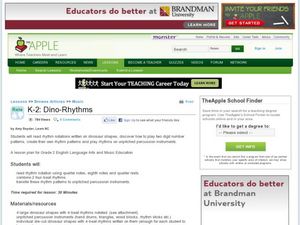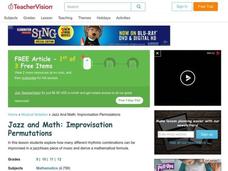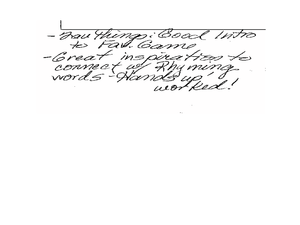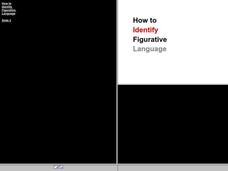Education Closet
Equal Rhythms
Engage young mathematicians in learning about fractions with this cross-curricular math and music instructional activity. After listening to and repeating different beat patterns, children realize that musical notes are just another way...
Curated OER
Catch the Beat
Use this rhythm and pattern activity during transition times or on it own. Start by introducing a rhythm with 2, 3, or 4 beats; use your feet, hands, or entire body to demonstrate. Once learners have figured out the pattern, they join...
TED-Ed
A-rhythm-etic. The Math Behind the Beats
Your learners will dance in their seats as this talented drummer connects math to music in a short video clip. Clayton Cameron shows how math puts the "cool" in various genres of music, including jazz, hip-hop, pop, R&B, and others,...
Curated OER
Math, Fractions, and Music
Young scholars discover the relationship between musical rhythms and fractions. They add musical notes together to produce fractions and create addition and subtraction problems with musical notes. Students complete worksheets and create...
Curated OER
K-2: Dino-Rhythms
Second graders read rhythm notation and combine four-beat rhythms. In this rhythms lesson, 2nd graders read quarter notes, eighth notes, and quarter rests in rhythms that are written on dinosaur shapes. They clap, snap, or stamp out the...
Hawaiʻi State Department of Education
Rhythm Patterns
Fractions can be tricky. Why not have kids think of fractions like they think of eighth, quarter, and half notes? In teams, the class creates four-measure patterns with their percussion instruments. They need to explain their rhythm...
Curated OER
How Do I Measure Up? (Intermediate)
Fifth graders compare the relationship between meter in music and measurement in math. They practice sightreading music by determining the number of beats per measure, clapping and counting the rhythm.
Curated OER
Jazz and Math: Improvisation Permutations
Students observe that there are myriad combinations of rhythms to choose from when improvising jazz and blues music, and recognize that while the variations seem infinite, they are in fact finite. They notate a 12 bar blues progression...
Curated OER
Classroom Builder
Students explore music theory by discussing a classic song. In this musical notation lesson, students listen to the song "My Favorite Things" and discuss and share their personal tastes with the class. Students practice writing notes on...
Curated OER
Tony Bennett: With Special Guests The Backstreet Boys - Lesson 2
Students clap four-beat rhythm patterns containing whole, half, dotted half, quarter, and eighth notes and rests in a given tempo. They clap the tempo as their teacher holds up flash cards.
Curated OER
The Importance of Patterns
Learners study geometric shapes and find patterns in shapes, numbers, and beats. For this patterns lesson, students complete a handout 'Guess the Pattern and watch a video about breaking a code. Learners read a word problem and watch a...
Curated OER
Locomotion, Time And Shapes
Students practice the concepts of time and rhythm using drum beats. They also create body shapes using verbal cues. The shapes made include stretched, curled, angular, or twisted. The rhythm of beats is increased or decreased to explore...
Curated OER
Tap Your Feet
Students listen to, analyze, and describe music. They experience performing on instruments, alone and with others, a varied repertoire of music.
Curated OER
How To Identify Figurative Language
Students investigate writing techniques by analyzing a chart. In this figurative language lesson, students define similes, metaphors and identify the difference between them and personification. Students demonstrate their understanding...
Hawaiʻi State Department of Education
Pease Porridge
Practice using different ways to express a single pattern. The class uses concrete, pictorial, and numerical modes to represent patterns found in a simple rhyme. They will move their bodies, use body percussion, draw, and use numbers to...
















